-
Happy Birthday ICMag! Been 20 years since Gypsy Nirvana created the forum! We are celebrating with a 4/20 Giveaway and by launching a new Patreon tier called "420club". You can read more here.
-
Important notice: ICMag's T.O.U. has been updated. Please review it here. For your convenience, it is also available in the main forum menu, under 'Quick Links"!
You are using an out of date browser. It may not display this or other websites correctly.
You should upgrade or use an alternative browser.
You should upgrade or use an alternative browser.
Homebrewing/Beer Makers Thread
- Thread starter gtbuds2332
- Start date
ItsAllOver
Devil's Advocate
Really? Are you sure there isn't some other variable at task here? I figure you'd know it if you were having bacterial contaminations...
mr. bojangles
Member
Hrmm maybe mr. bojangles can tell us if the isod hops and hash sank or swam or seemed to evenly disperse when he added it?
I'm curious too as I don't want it ending up in the yeast slop no one drinks in the bottle of the fermentation barrel, although I often reuse that to make turbo cider so I have a chance of getting some of it back maybe?
I think this thread might end up in link o rama soon. Surely making good weed tasting and fueled brews is faq worthy
I added the iso wash in the secondary along with some fresh hops everyday for two weeks( the dry hop that is, not the iso
 It's a little dry in the finish, probably due to the the champange yeast I use in the secondary to boost the alc. content, but also because of the iso I think. I've brewed this particular recipe a few times now and you can defintly tell the difference. Ithink I'll tweek it alittle more, maybe use a little shine instead of iso
It's a little dry in the finish, probably due to the the champange yeast I use in the secondary to boost the alc. content, but also because of the iso I think. I've brewed this particular recipe a few times now and you can defintly tell the difference. Ithink I'll tweek it alittle more, maybe use a little shine instead of iso Oh, yeah and I always drink the yeast, it's got tons of good stuff in there, especially for the immune system
Oh, yeah and I always drink the yeast, it's got tons of good stuff in there, especially for the immune system

peace ya'll
i love beer..wish this thread was more understandible..i have no clue how things mix and what the setup could look like as there's no pictures on this post or details..but this is something in my to do list guess i will have to learn on my own..cheers
ItsAllOver
Devil's Advocate
DG what are you confused about? THC delivery in beer (which it seems we are all still learning) or just brewing in general?
DG what are you confused about? THC delivery in beer (which it seems we are all still learning) or just brewing in general?
just brewing..step by step..i know all abot hops yeast , barley and malt..but what and how its use to mix in is where i'm lost..
ItsAllOver
Devil's Advocate
May I recommend a book in an effort to save my own time?
How to Brew is available online.
I really liked Charlie Papazian's book, too...
How to Brew is available online.
I really liked Charlie Papazian's book, too...
KruidenDctreren
New member
It seems that most folks in the thread are brewing beer. Gotta be some wine makers here as well...?
I've been making wine for several years. Grape wines are great but I enjoy experimenting with different fruits, herbs, teas, and vegetables - or in other words anything with a sufficient amount of sugar. Unfortunately, I have yet to try our most preferred herb. I have some ideas and wanted to see if anyone had experience or suggestions for incorporating cannabis into the wines without diminishing flavor. Again, I know this is a beer thread but at least the initial fermentation process is similar if not the same.
1. Fermenting fresh, undried buds along with supplemental sugar and using this to blend with other wines since I can't imagine the taste being desirable... I imagine a mix of 1 cup herb wine to 1 gallon of "conventional" wine.
2. Allowing dried buds to soak in the water to be added to the brew mix and hopefully extracting a significant amount of thc...
3. Fortified wines are often the result of adding high-grain alcohol to the wine to prematurely stop the fermentation process thus allowing commercial wineries to get the product to shelf more quickly, so... soak dried buds in the high-grain alcohol trying to extract as much thc as possible and then use this alcohol in the commercial process previously mentioned.
4. I have had excellent experiences with brewing tea wines. The fragrance and taste are exceptional and the lacking body can be made up with by blending a couple of cups high-pectin fruit wine, ie. plum. Maybe a cannabis tea brew?
Any suggestions from past experiences? Also, it seems that genetics best for hash making would be best for brewing as well, agreed?
I also wonder how quickly the thc in any of these methods would degrade as some wines I prefer to periodically rack, or shelve for several years before enjoying. And on this same note, would thc survive the distillation process?
I've been making wine for several years. Grape wines are great but I enjoy experimenting with different fruits, herbs, teas, and vegetables - or in other words anything with a sufficient amount of sugar. Unfortunately, I have yet to try our most preferred herb. I have some ideas and wanted to see if anyone had experience or suggestions for incorporating cannabis into the wines without diminishing flavor. Again, I know this is a beer thread but at least the initial fermentation process is similar if not the same.
1. Fermenting fresh, undried buds along with supplemental sugar and using this to blend with other wines since I can't imagine the taste being desirable... I imagine a mix of 1 cup herb wine to 1 gallon of "conventional" wine.
2. Allowing dried buds to soak in the water to be added to the brew mix and hopefully extracting a significant amount of thc...
3. Fortified wines are often the result of adding high-grain alcohol to the wine to prematurely stop the fermentation process thus allowing commercial wineries to get the product to shelf more quickly, so... soak dried buds in the high-grain alcohol trying to extract as much thc as possible and then use this alcohol in the commercial process previously mentioned.
4. I have had excellent experiences with brewing tea wines. The fragrance and taste are exceptional and the lacking body can be made up with by blending a couple of cups high-pectin fruit wine, ie. plum. Maybe a cannabis tea brew?
Any suggestions from past experiences? Also, it seems that genetics best for hash making would be best for brewing as well, agreed?
I also wonder how quickly the thc in any of these methods would degrade as some wines I prefer to periodically rack, or shelve for several years before enjoying. And on this same note, would thc survive the distillation process?
gtbuds2332
Member
I want to show the basic brewing process by showing you how I made a Belgian Ale a few months ago. There are a few things that are done differently in brewing different beers but this is a basic explanation. Here is the recipe to make 5 gallons or about 50 beers...
Fermantables
7 lbs Pale Malt Extract Syrup
1 lb Belgian Aromatic
1 lb Light Belgian Candy Sugar
5 oz Priming Sugar
Hops
1.75 oz Styrian Goldings (60 mins)
1/2 oz Styrian Goldings (10 mins)
Other Ingredients
1 oz Coriander (10 mins)
1 oz Blue Spruce Tips (10 mins)
1 tsp Irish Moss (15 mins)
1 Orange's worth off zest (end of boil)
1 Package Safbrew S-33 Dry Yeast

The first step in brewing is to sanitize ALL the equipment you will be using. This can be done with a soaking in bleach or using a no rinse sanitizer as I use. This is a very important step because if not done properly your beer could be ruined by bacteria. Next the grains are put into a grain bag and put into a 5 gallon pot with 3 gallons of water. Heat the water to 155 degrees and let the grains steep for 30 mins.
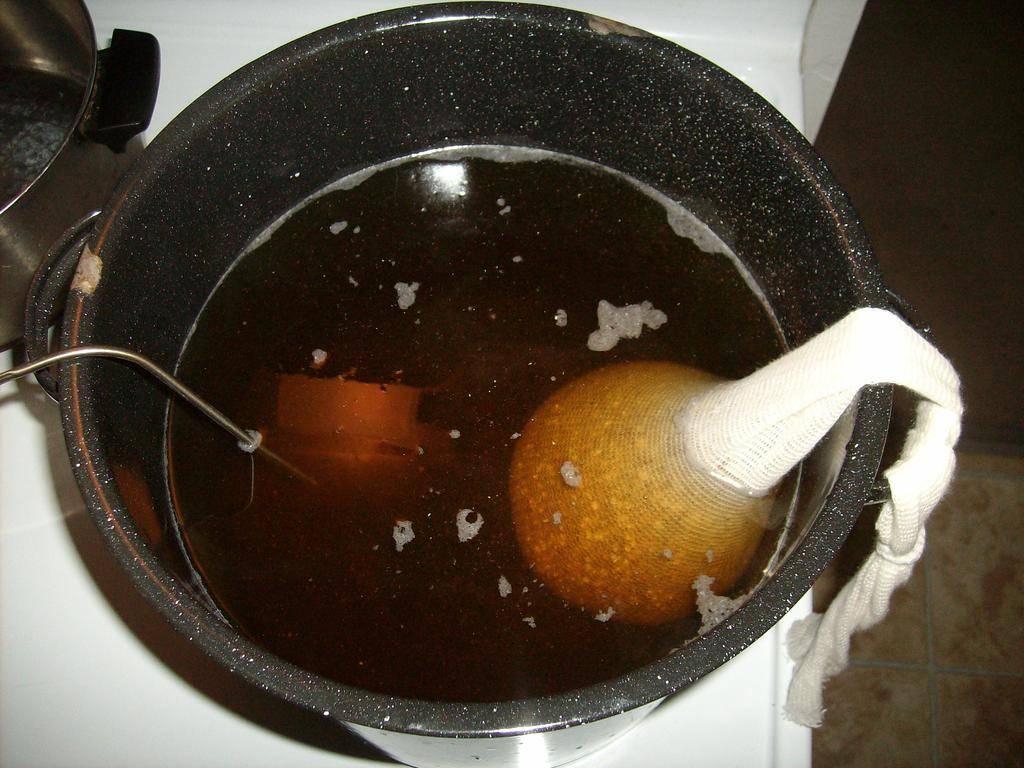
After 30 minutes take the grain bag out and bring the water up to a boil. Once the water starts to boil it is time to add the malt extract syrup and Belgian candy sugar. To do this take the pot off the heat to avoid boil over because the extract makes the brew foam up at first. After you have added all the malt extract and candied sugar put the pot back on the heat and return to a boil. DO NOT LEAVE POT unwatched from this point on as boil overs can happen anytime. Once your brew returns to a boil it is time to add the first 1.75 oz addition of hops, which will be the bittering hops. This is what it looks like...
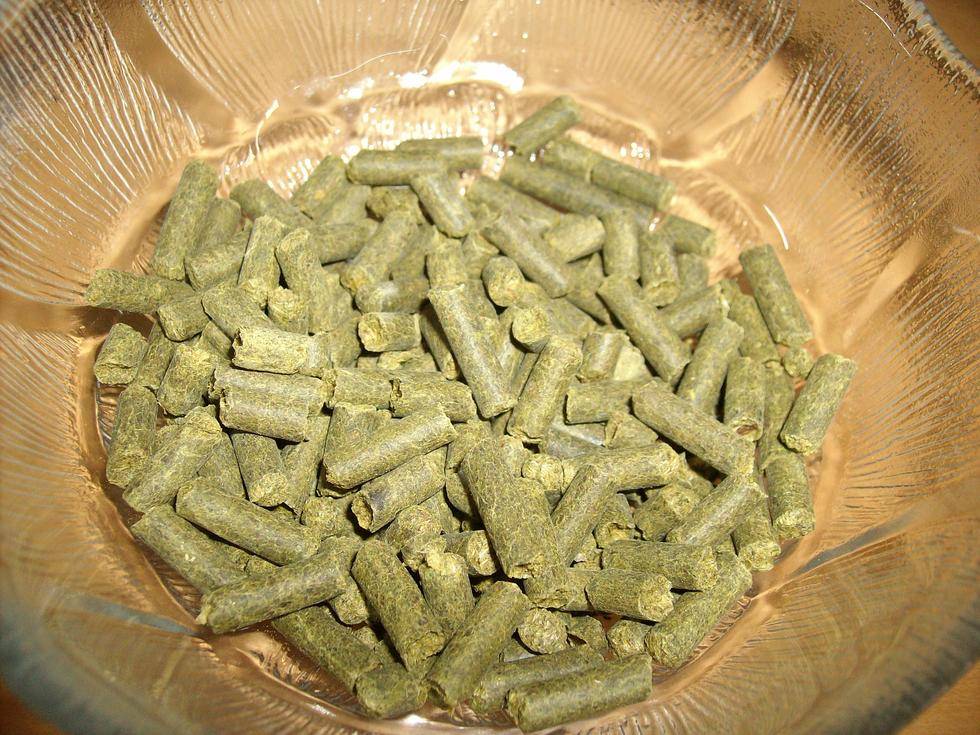
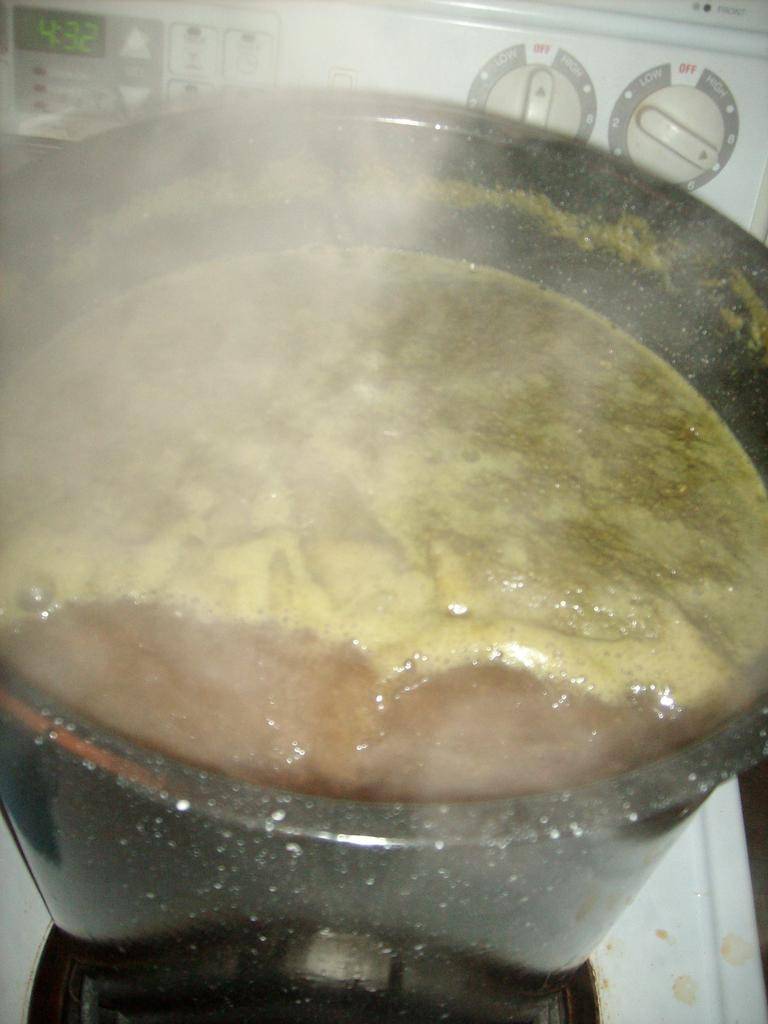
When these hops are added start a timer for 60 minutes as this is how long you will be boiling the brew. Continue the boil and stir occasionally until the next addition. With 15 minutes left add 1 tsp of Irish Moss which helps make the beer nice and clear. At 10 mins left in the boil add the 1/4 oz of hops which will be the flavoring hops. Also at 10 mins left add the 1 oz of coriander and 1 oz of blue spruce tips. When the 60 minutes is up add the zest of 1 orange.
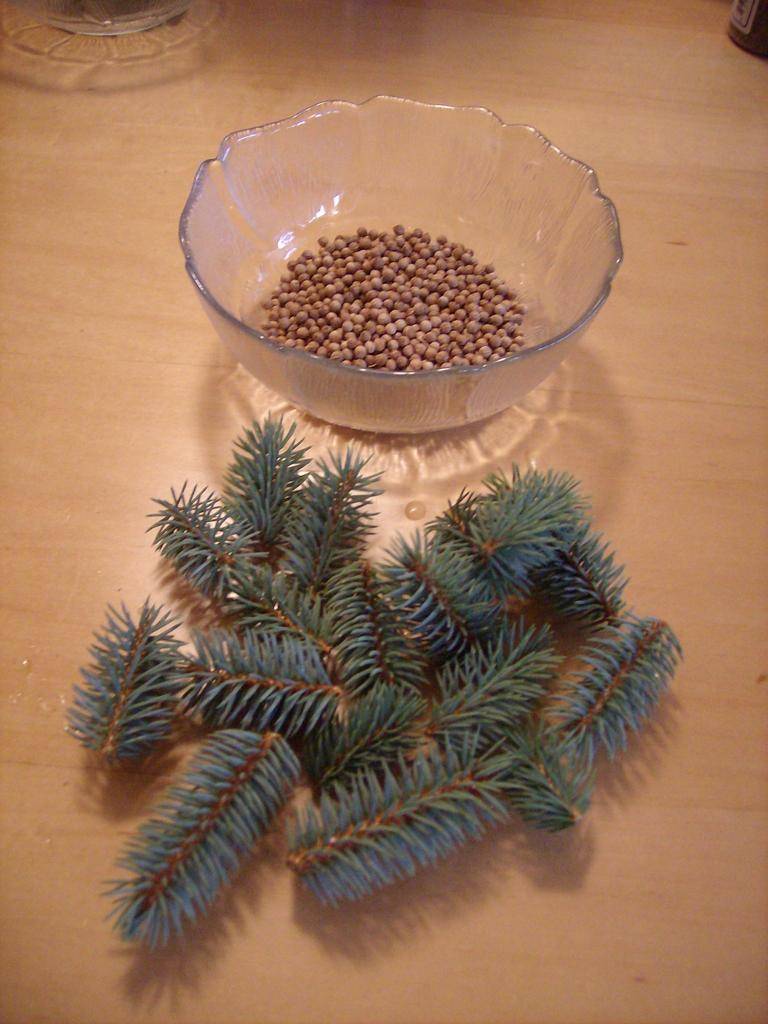

This mixture is now called "wort" or unfermented beer. The wort needs to be cooled down under 90 degrees in order to add the yeast without killing it. There are a few ways to do this. You can purchase a copper coil that uses water from the faucet to transfer heat out of the wort. This is expensive to purchase so another option is to put the pot of wort into an ice bath but this will take a while to cool down. After the wort is cooled below 90 degrees it can be poured through a strainer into the fermentation bucket. Since we only boiled 3 gallons of water you have to add water to get it to the 5 gallon mark that we want.
Lately I have been skipping the normal cooling process by adding a bag of ice into the fermenting bucket and pouring/straining the hot wort strait in. This usually brings the temp down enough and then I just add some water to top it off to 5 gallons. Either way once you have your 5 gallons of cooled wort it is time to pour the yeast in. Put the lid on the bucket and shake to aerate the wort to give you happy yeast. An air-lock stopper is added to let the CO2 escape and not let any air in during fermentation. This is what the bucket and stopper look like.

Let this ferment for 1 week at room temperature and then it can either be bottled or siphoned into a secondary fermenter to let the beer clarify more. I let this go in the secondary for 2 weeks. After fermentation is done it is time to bottle.
When bottling you have to add something called "priming sugar" in order to get the beer to have carbonation. To do this boil 1 cup of water and add 5 oz of the priming sugar. Boil for 10 mins and then pour into a bottling bucket. Then siphon the beer into the bottling bucket containing the priming sugar.
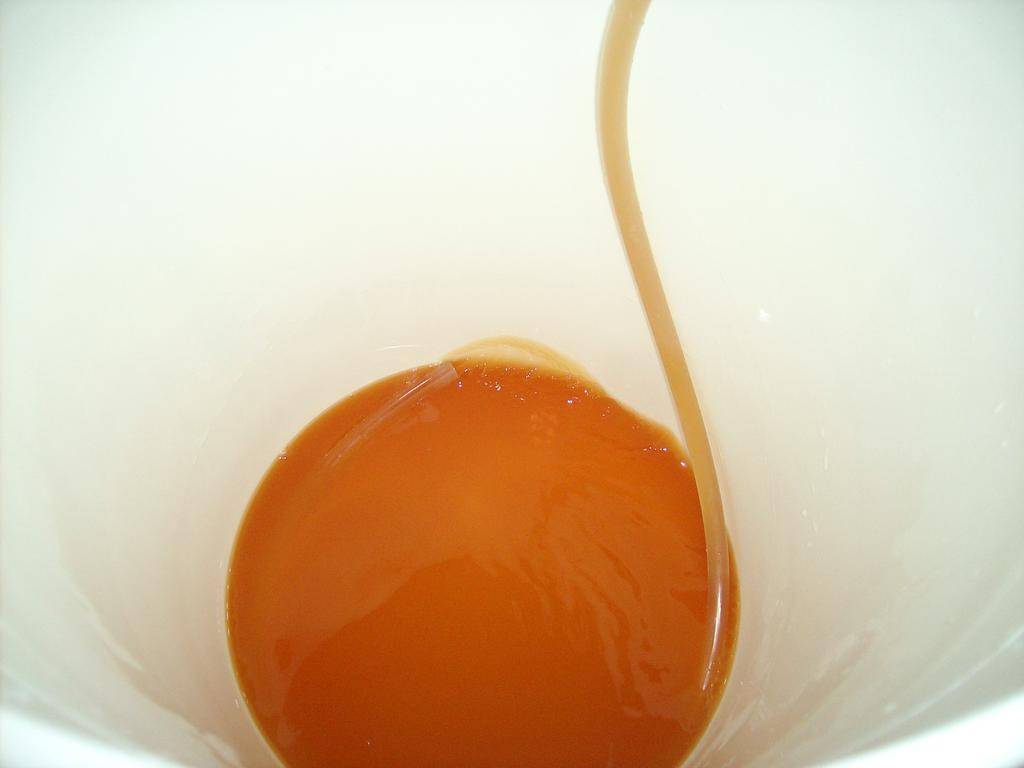
Bottles are then filled using a filler wand and capped. Store in dark place for 2 weeks before drinking and then ENJOY! The beer will become even better tasting after a month or two!
Good luck and happy brewing!
Fermantables
7 lbs Pale Malt Extract Syrup
1 lb Belgian Aromatic
1 lb Light Belgian Candy Sugar
5 oz Priming Sugar
Hops
1.75 oz Styrian Goldings (60 mins)
1/2 oz Styrian Goldings (10 mins)
Other Ingredients
1 oz Coriander (10 mins)
1 oz Blue Spruce Tips (10 mins)
1 tsp Irish Moss (15 mins)
1 Orange's worth off zest (end of boil)
1 Package Safbrew S-33 Dry Yeast
The first step in brewing is to sanitize ALL the equipment you will be using. This can be done with a soaking in bleach or using a no rinse sanitizer as I use. This is a very important step because if not done properly your beer could be ruined by bacteria. Next the grains are put into a grain bag and put into a 5 gallon pot with 3 gallons of water. Heat the water to 155 degrees and let the grains steep for 30 mins.
After 30 minutes take the grain bag out and bring the water up to a boil. Once the water starts to boil it is time to add the malt extract syrup and Belgian candy sugar. To do this take the pot off the heat to avoid boil over because the extract makes the brew foam up at first. After you have added all the malt extract and candied sugar put the pot back on the heat and return to a boil. DO NOT LEAVE POT unwatched from this point on as boil overs can happen anytime. Once your brew returns to a boil it is time to add the first 1.75 oz addition of hops, which will be the bittering hops. This is what it looks like...
When these hops are added start a timer for 60 minutes as this is how long you will be boiling the brew. Continue the boil and stir occasionally until the next addition. With 15 minutes left add 1 tsp of Irish Moss which helps make the beer nice and clear. At 10 mins left in the boil add the 1/4 oz of hops which will be the flavoring hops. Also at 10 mins left add the 1 oz of coriander and 1 oz of blue spruce tips. When the 60 minutes is up add the zest of 1 orange.
This mixture is now called "wort" or unfermented beer. The wort needs to be cooled down under 90 degrees in order to add the yeast without killing it. There are a few ways to do this. You can purchase a copper coil that uses water from the faucet to transfer heat out of the wort. This is expensive to purchase so another option is to put the pot of wort into an ice bath but this will take a while to cool down. After the wort is cooled below 90 degrees it can be poured through a strainer into the fermentation bucket. Since we only boiled 3 gallons of water you have to add water to get it to the 5 gallon mark that we want.
Lately I have been skipping the normal cooling process by adding a bag of ice into the fermenting bucket and pouring/straining the hot wort strait in. This usually brings the temp down enough and then I just add some water to top it off to 5 gallons. Either way once you have your 5 gallons of cooled wort it is time to pour the yeast in. Put the lid on the bucket and shake to aerate the wort to give you happy yeast. An air-lock stopper is added to let the CO2 escape and not let any air in during fermentation. This is what the bucket and stopper look like.
Let this ferment for 1 week at room temperature and then it can either be bottled or siphoned into a secondary fermenter to let the beer clarify more. I let this go in the secondary for 2 weeks. After fermentation is done it is time to bottle.
When bottling you have to add something called "priming sugar" in order to get the beer to have carbonation. To do this boil 1 cup of water and add 5 oz of the priming sugar. Boil for 10 mins and then pour into a bottling bucket. Then siphon the beer into the bottling bucket containing the priming sugar.
Bottles are then filled using a filler wand and capped. Store in dark place for 2 weeks before drinking and then ENJOY! The beer will become even better tasting after a month or two!
Good luck and happy brewing!
ItsAllOver
Devil's Advocate
Nice runthru man. I'll have to post my recipe for the
Imperial Breakfast Oatmeal Porter I just concocted. It's freaking fantastic and sits at 7.5% ABV
Back later
Imperial Breakfast Oatmeal Porter I just concocted. It's freaking fantastic and sits at 7.5% ABV
Back later
gtbuds2332
Member
thanks man! that porter sounds awesome! looking forward to that recipe
and that reminds me, the Belgian Ale above is 7% ABV
and that reminds me, the Belgian Ale above is 7% ABV
"Oh, yeah and I always drink the yeast" Ah, so I'm not alone 
mr. bojangles
Member
phellowship
Member
i have a friend that brews and he says the smell is very strong when brewing just beer .he says u can smell it form a good block away,how much more does this stink with weed in the mix
ItsAllOver
Devil's Advocate
Be sure to click the links to get schooled on terms you don't recognize!
Be sure to click the links to get schooled on terms you don't recognize!
Too Many Adjectives Imperial Breakfast Maple Oatmeal Porter
(mostly all grain but I could figure out a ME version if anyone wants it)
Category: Robust Porter
Alcohol by Volume: 7.5%
IBU: ~44
Batch Volume: 5.2 gallons
Boil Time: 75 minutes
Original Gravity: 1.078 (this was my first all-grain run that I hit all marks right on the dot! WOO!)
Final Gravity: 1.021
Fermentables:
9 lb. - American 2-Row
1.5 lb - Oats (flaked)
1.0 lb - Dark DME
1.0 lb - German Munich
1.0 lb - American Crystal 90L
0.75 lb - American Chocolate Malt
0.5 lb - American Black Patent
0.5 lb - American Vienna
16 fluid ounces - Maple Syrup. Get some dankity dank.
Hops:
1 oz. - Centennial - Boil for 45 minutes
1 oz. - Perle - Boil for 25 minutes
Wyeast 1084 - Irish Ale yeast (go for two smack packs to get a good strong fermentation)
Funny story here... I pitched my smack pack of Wyeast 1084, but had no activity within 6 hours, which is impatient, BTW, but I was concerned that I had underpitched (pitched too little yeast). So I pitched about a half-pack of Nottingham dry yeast, which is known for having a mild character and strong fermentation and flocculation properties. I wouldn't recommend mixing yeasts on a regular basis, but my recipe turned out great anyway.
Mash at 154 for 60 minutes. I use a grain ratio of 1.25 quarts water / pound of grain. I batch sparge, too, so just use the ratio initially, then drain your mash tun. It is important to drain your mash tun very slowly, as in 1 - 1.5 quarts per minute, to ensure that a good grain filter is produced and that you extract as much sugar as possible from the grains. Don't forget to vorlauf the first half-gallon or so of your runnings! I then add 5 gal of 170 degree water, stir, and let sit for another 15 minutes. Then drain until the level in your kettle is at 7.84 gallons to account for boil-off over the 75 minute boil. Adjust boil strength as the boil progresses to achieve 5.2 gals at 75 minutes.
(Tip! : Before ever using my kettle, I poured known volumes of water into it and used a tape measure to figure out the length between the rivets for the handles to the water surface. I wrote all the values down and I have a ghetto way to know the volume in my pot. It's hard to know the volume when it's boiling, tho, because the water is turbulent. A good guess is about enough for a little while, but I might get a sight glass soon.)
Near the end of the boil, drop in your pre-cleaned and sanitized copper pipe racking cane to sterilize it. At flame-out, move the kettle to a counter or something (so you can siphon the wort) and use the racking cane to stir the wort and create a whirlpool. This way you can let it sit for a few minutes while all the hops and other possible particulates will collect in the middle of the kettle in kind of a cone shape and you can avoid siphoning it out when you move it to the fermenter. I drop my copper coil heat exchanger in the sink and pack in ice and ice water, then run the wort through that to cool it before going into the fermenter. It's seriously hard to get the siphon started, but it works. I'm going to try immersing the coil in the pot and running tap water thru it to cool next time. I think that will work more quickly and will be less likely to contaminate a batch, not that I've had that problem yet. I hope I can avoid it!
Pitch your yeast when the wort gets to 80ish.
At secondary, add in 16 fluid ounces of maple syrup (preboiled for a minute, then cover the pot with sanitized aluminum foil and placed in freezer to cool)
I don't remember exactly how long I fermented for, but I think it was like 14-18 days. Just check the gravity at transfer to secondary once 7 days is up, then check again at 14 days.
I'll post up a Sip Report in a few minutes when the one I just tossed in the fridge is chilled down. It's a great, snowed-in day for this kind of beer. Just what I brewed it for!
Feel free to PM me about any questions related to brewing, or just ask them here.
Peace
Be sure to click the links to get schooled on terms you don't recognize!
Too Many Adjectives Imperial Breakfast Maple Oatmeal Porter
(mostly all grain but I could figure out a ME version if anyone wants it)
Category: Robust Porter
Alcohol by Volume: 7.5%
IBU: ~44
Batch Volume: 5.2 gallons
Boil Time: 75 minutes
Original Gravity: 1.078 (this was my first all-grain run that I hit all marks right on the dot! WOO!)
Final Gravity: 1.021
Fermentables:
9 lb. - American 2-Row
1.5 lb - Oats (flaked)
1.0 lb - Dark DME
1.0 lb - German Munich
1.0 lb - American Crystal 90L
0.75 lb - American Chocolate Malt
0.5 lb - American Black Patent
0.5 lb - American Vienna
16 fluid ounces - Maple Syrup. Get some dankity dank.
Hops:
1 oz. - Centennial - Boil for 45 minutes
1 oz. - Perle - Boil for 25 minutes
Wyeast 1084 - Irish Ale yeast (go for two smack packs to get a good strong fermentation)
Funny story here... I pitched my smack pack of Wyeast 1084, but had no activity within 6 hours, which is impatient, BTW, but I was concerned that I had underpitched (pitched too little yeast). So I pitched about a half-pack of Nottingham dry yeast, which is known for having a mild character and strong fermentation and flocculation properties. I wouldn't recommend mixing yeasts on a regular basis, but my recipe turned out great anyway.
Mash at 154 for 60 minutes. I use a grain ratio of 1.25 quarts water / pound of grain. I batch sparge, too, so just use the ratio initially, then drain your mash tun. It is important to drain your mash tun very slowly, as in 1 - 1.5 quarts per minute, to ensure that a good grain filter is produced and that you extract as much sugar as possible from the grains. Don't forget to vorlauf the first half-gallon or so of your runnings! I then add 5 gal of 170 degree water, stir, and let sit for another 15 minutes. Then drain until the level in your kettle is at 7.84 gallons to account for boil-off over the 75 minute boil. Adjust boil strength as the boil progresses to achieve 5.2 gals at 75 minutes.
(Tip! : Before ever using my kettle, I poured known volumes of water into it and used a tape measure to figure out the length between the rivets for the handles to the water surface. I wrote all the values down and I have a ghetto way to know the volume in my pot. It's hard to know the volume when it's boiling, tho, because the water is turbulent. A good guess is about enough for a little while, but I might get a sight glass soon.)
Near the end of the boil, drop in your pre-cleaned and sanitized copper pipe racking cane to sterilize it. At flame-out, move the kettle to a counter or something (so you can siphon the wort) and use the racking cane to stir the wort and create a whirlpool. This way you can let it sit for a few minutes while all the hops and other possible particulates will collect in the middle of the kettle in kind of a cone shape and you can avoid siphoning it out when you move it to the fermenter. I drop my copper coil heat exchanger in the sink and pack in ice and ice water, then run the wort through that to cool it before going into the fermenter. It's seriously hard to get the siphon started, but it works. I'm going to try immersing the coil in the pot and running tap water thru it to cool next time. I think that will work more quickly and will be less likely to contaminate a batch, not that I've had that problem yet. I hope I can avoid it!
Pitch your yeast when the wort gets to 80ish.
At secondary, add in 16 fluid ounces of maple syrup (preboiled for a minute, then cover the pot with sanitized aluminum foil and placed in freezer to cool)
I don't remember exactly how long I fermented for, but I think it was like 14-18 days. Just check the gravity at transfer to secondary once 7 days is up, then check again at 14 days.
I'll post up a Sip Report in a few minutes when the one I just tossed in the fridge is chilled down. It's a great, snowed-in day for this kind of beer. Just what I brewed it for!
Feel free to PM me about any questions related to brewing, or just ask them here.
Peace
gtbuds2332
Member
nice man! thanks for the report, I cant wait to hear how it turned out!


